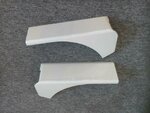Good morning all, looking for recommendations please.
Subject caravan is a 2016 Swift 560.
I have a couple of small cracks in the rear panel around the high level marker lights. Nothing worrying but I would like to address them sooner rather than later. I intend to use Captain Tolleys crack sealer first then slightly vee out the surface and then fill with an epoxy. Can anyone please recommend an epoxy to use? Preferably white.
I will drill a 2mm hole at the end of the crack beforehand. Thanks all.
Best regards
R
Subject caravan is a 2016 Swift 560.
I have a couple of small cracks in the rear panel around the high level marker lights. Nothing worrying but I would like to address them sooner rather than later. I intend to use Captain Tolleys crack sealer first then slightly vee out the surface and then fill with an epoxy. Can anyone please recommend an epoxy to use? Preferably white.
I will drill a 2mm hole at the end of the crack beforehand. Thanks all.
Best regards
R



